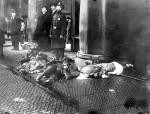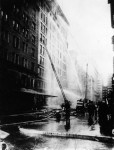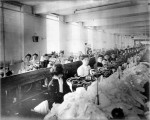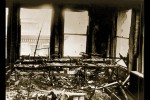 March 25, 2011 will be the hundredth anniversary of the tragic fire at Greenwich Village’s Triangle Shirtwaist Factory which saw 146 young men, women and children die burned, or trampled, or from hurling themselves out of the top stories’ windows in a desperate attempt to flee the fire. It was New York City’s largest workplace disaster until 9/11.
March 25, 2011 will be the hundredth anniversary of the tragic fire at Greenwich Village’s Triangle Shirtwaist Factory which saw 146 young men, women and children die burned, or trampled, or from hurling themselves out of the top stories’ windows in a desperate attempt to flee the fire. It was New York City’s largest workplace disaster until 9/11.
 A huge crowd of onlookers bore horrified witness to a carnage that even the remarkably swift action of firefighters (it only took them a few minutes to get there and half an hour to put out the fire) could not prevent. The ladders on their engines only reached the 6th floor, and the water pumps of the era weren’t strong enough to force water to the top of the building.
A huge crowd of onlookers bore horrified witness to a carnage that even the remarkably swift action of firefighters (it only took them a few minutes to get there and half an hour to put out the fire) could not prevent. The ladders on their engines only reached the 6th floor, and the water pumps of the era weren’t strong enough to force water to the top of the building.
 Owned by Max Blanck and Isaac Harris, the Triangle Factory in the Asch Building was notorious for dangerous working conditions. Shirtwaists, women’s blouses that were popular in the late Victorian and Edwardian era, were made in rooms full of young, mainly female immigrants. They were crammed back to back along 75-foot tables. There were work baskets filled with loose cotton scraps in the aisles and on the tables. These were a major fire hazard because loosely-packed pieces of cotton ignite immediately into a blaze; there’s no slow burn or delicate plumes of smoke to warn you.
Owned by Max Blanck and Isaac Harris, the Triangle Factory in the Asch Building was notorious for dangerous working conditions. Shirtwaists, women’s blouses that were popular in the late Victorian and Edwardian era, were made in rooms full of young, mainly female immigrants. They were crammed back to back along 75-foot tables. There were work baskets filled with loose cotton scraps in the aisles and on the tables. These were a major fire hazard because loosely-packed pieces of cotton ignite immediately into a blaze; there’s no slow burn or delicate plumes of smoke to warn you.
 The owners locked the back exit to prevent workers from absconding with a few bucks worth of fabric or thread, leaving only one way out in case of emergency, plus a rickety fire escape ladder that stopped two stories before the ground. The fire escape ladder would buckle under the weight of the fleeing workers, dropping them to a crushing death.
The owners locked the back exit to prevent workers from absconding with a few bucks worth of fabric or thread, leaving only one way out in case of emergency, plus a rickety fire escape ladder that stopped two stories before the ground. The fire escape ladder would buckle under the weight of the fleeing workers, dropping them to a crushing death.
Blanck and Harris also had an enormously shady record of multiple early morning fires breaking out in two different factory locations. Said early morning fires just happened to coincide with the close of the peak shirtwaist selling season, thus destroying their inventory surplus while more than covering their losses with the payout from their insurance.
In 1909, 400 Triangle Factory employees had walked out, inspiring 20,000 garment workers from all over the city to follow in a general strike on November 23. Blanck and Harris hired prostitutes as scab workers and their pimps and the police to taunt and beat on the picketing workers. When in 1910 the cloakmakers joined the strike, industry and labor leaders signed an agreement that in theory established a grievance system in the garment industry. In practice, unscrupulous owners like Max Blanck and Isaac Harris just ignored it.
 In the wake of the horrific deaths, on April 11th Harris and Blanck were indicted on seven counts of second degree manslaughter on the grounds that it was a violation of the Labor Code to keep a door locked during working hours. On December 27th, a jury acquitted of them of all charges, even though multiple witnesses testified that the Washington St. exit door was locked leaving workers with no escape when the Greene St. exit was choked with fire. The owners’ defense attorney, Max Steuer, cast doubt on the testimony by making the main witness, Kate Alterman, repeat her story over and over, then pointing to her repetition of certain words and phrases as the mark of memorization or coaching. He suggested a socialist conspiracy was afoot, a conspiracy that also explained the discovery of the actual locked lock from the Washington St. door 16 days after the fire.
In the wake of the horrific deaths, on April 11th Harris and Blanck were indicted on seven counts of second degree manslaughter on the grounds that it was a violation of the Labor Code to keep a door locked during working hours. On December 27th, a jury acquitted of them of all charges, even though multiple witnesses testified that the Washington St. exit door was locked leaving workers with no escape when the Greene St. exit was choked with fire. The owners’ defense attorney, Max Steuer, cast doubt on the testimony by making the main witness, Kate Alterman, repeat her story over and over, then pointing to her repetition of certain words and phrases as the mark of memorization or coaching. He suggested a socialist conspiracy was afoot, a conspiracy that also explained the discovery of the actual locked lock from the Washington St. door 16 days after the fire.
In the end, Blanck and Harris made a tidy profit from the hideous death of 146 people. They filed insurance claims far in excess of their monetary losses and Steuer scared the insurance companies into settling for reimbursement in the amount of $60,000 above the documented loss. Steuer then prevented any of the Triangle Factory fire victims or survivors from collecting any of it. Blanck and Harris made $400 for every dead body.
Twenty-three civil suits were filed against them. They settled those lawsuits on March 11, 1914, almost three years to the day after the fire, with a payment of $75 per dead body. The year before that in the summer of 1913, Max Blanck had been arrested for locking yet another factory door. He got off with a $20 fine and an apology from the judge for having troubled him.
The tragedy of the fire and the sham of an aftermath galvanized the labor movement in New York City. The New York State Legislature created an investigating committee to report on factory conditions and how sanitation and worker safety issues could be addressed. Its 1915 report would be key to New York’s new laws that made the state one of the most progressive in the country in terms of labor relations.
The Occupational Safety & Health Administration, created 60 years after the fire, has a memorial page on its website in honor of the anniversary of the tragedy. The Industrial and Labor Relations School’s Kheel Center at Cornell University has an exceptional collection of photographs and primary sources on the fire and its aftermath.
On Monday PBS aired an American Experience episode about the tragedy entitled Triangle Fire which you can now view online. I saw it and it’s a solid overview, but a little short on details, especially about the aftermath. On March 21st, HBO will be airing its more in-depth documentary Triangle: Remembering the Fire, with the DVD to follow shortly.
If you’re in New York City, there will be a commemoration of the centennial on March 25th at 11 a.m. at the site of the fire, one block east of Washington Square Park in New York City. The building was one of them newfangled “fireproof” structures so it survived the fire even though its contents sure didn’t. It was refurbished and purchased by philanthropist Frederick Brown who donated it to New York University in 1929. Now it’s the Brown Building of Science, and Chemistry and Biology classes are held in it. Two plaques commemorate the victims of the 1911 fire.